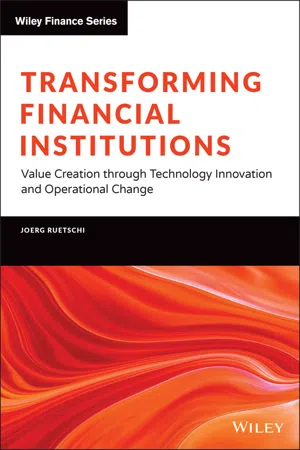
Transforming Financial Institutions
Value Creation through Technology Innovation and Operational Change
Joerg Ruetschi
- English
- ePUB (handyfreundlich)
- Über iOS und Android verfügbar
Transforming Financial Institutions
Value Creation through Technology Innovation and Operational Change
Joerg Ruetschi
Über dieses Buch
Transform your financialorganisation'sformula for value creation with this insightful and strategic approach
In TransformingFinancial Institutions through Technology Innovation and Operational Change, visionaryturnaroundleaderJoergRuetschideliversa practical andglobally relevant methodology and framework for value creation at financial institutions.The authordemonstrates how financialorganisationscancombinefinancestrategy with asset-liability and technology managementto differentiate their services and gain competitive advantage in a ferocious industry.
In addition to exploring the four critical areas ofstrategicand competitivetransformation—financial analysis, valuation, modeling, and stress—the bookincludes:
- Explanations of how to apply the managerial fundamentals discussed in the book in the real world, with descriptions of the principlesforreorganization, wind-downandoverallvalue creation
- An analysis of the four key emerging technologies in the financial industry: AI, blockchain, software, and infrastructure solutions, and their transformational impact
- Real-world case studies and exampleson how financial institutions can be repositioned and rebuilt on a path of profitability
Perfect for managers and decision makers in the financial services industry, TransformingFinancial Institutions through Technology Innovation and Operational Change is also required reading for regulators, tech firms, and private equity and venture capital funds.
Häufig gestellte Fragen
Information
PART One
Managerial Fundamentals
CHAPTER 1
Strategic Decision Making
1.1 STRATEGIC ANALYSIS
1.1.1 Hypothesis‐driven problem solving
- Simplify and reduce complexity by stating early an initial hypothesis which leads to a result‐driven analysis.
- Specify and focus through identifying key drivers in a designated analytical framework that is mutually exclusive collectively exhaustive (MECE).
- Quantify and validate through available information and related data.

Baseline, structure, and hypotheses
Step 1: Understand the situation and assess the problem
Step 2: Frame the problem through hypotheses and structure a framework
- – Set up the analytical framework through defining the issues in a structured approach with its key drivers and m...